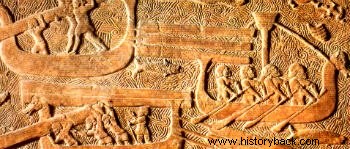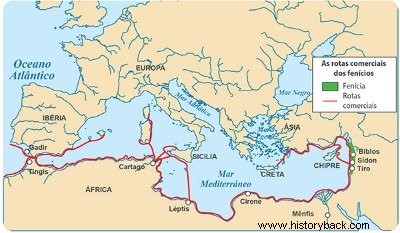The Phoenicians are part of one of the most important civilizations of antiquity – the Phoenician civilization.
They lived in northern Palestine, between the Mediterranean Sea and the territory that today corresponds to Lebanon, Syria and Israel.
The Phoenicians are known as the people of the sea. This is because they were great maritime merchants and contributed to the development of Astronomy.
The Persians and Hebrews also stand out in ancient civilization.
Map of Phoenician city-states and their trade routes
Hebrews, Phoenicians and Persians
The Phoenicians lived and traded with various peoples. They had as neighbors the Hebrews who also lived in the region where the present State of Israel is located.
With the Persians, in addition to trade, the Phoenicians still had to face them as enemies due to the expansion of the Persian Empire.
Read more about Hebrews and Persians.
Religion
The religion of Phoenicia was Polytheism where they practiced animal sacrifice rituals.
The Phoenicians mainly worshiped three gods, who are known by different names:
El - was the ultimate god - the one who had created the world, but not necessarily the gods. Nothing happened without his consent and that's why he knows everything. El is represented as an old man, sitting on top of a mountain, far from humanity. To obtain his graces, the faithful must turn to his wife, Astarte.
Asherah - wife of El - mother goddess, of the sea, of the herds and of the harvests. One of her symbols is the palm tree, a tree that stands out in the desert for its resistance, just as it stands out among the gods.
Baal - son of El and Astarte - was the god of storms and mountains, in charge of fertility. He is known by various titles such as Knight of the Clouds or Master of the Lands, a warrior who fights the forces of death. As El's son he also acts as regent in his father's absence.
Economy

High relief showing the landing of wood by Phoenician navigators
The Phoenicians dedicated themselves to handicrafts, even inventing transparent glass. In agriculture, they cultivated olives and vineyards, and dedicated themselves especially to fishing and maritime trade.
They did not develop major agricultural activities considering that the region they inhabited was mountainous and not very extensive.
Expanded fabric dyeing techniques. Of note is the dyeing with a purple hue, made from a mollusc and which was much sought after by the elite. From this color comes the word "Phoenician".
They built large and imposing ships that allowed them to expand their trade. They built ports and traveled long distances trading goods such as cedar wood, glass, ivory and dyes.
Policy
It is important to point out that there was never a unified country called “Phoenicia” as we understand it today.
Phoenicia was made up of several city-states, such as Arad, Byblos, Tyre, Sidon and Ugarit. Each of these cities was governed independently so that they could be allied with each other and war with each other.
Political power was based on sea routes and was in the hands of the men who dominated the sea, constituting the Thalassocracy.
This word comes from the Greek and means “thálassa ”- sea and “kratía ”- strength, power.
Culture
Phoenician culture received influences from the people they traded to the point that many scholars identify few original elements.
However, they excelled in minting coins and printed the designs of their boats and myths there.
They used music and dance to praise the gods in rituals performed in the countryside or in the center of cities.
Alphabet
The greatest legacy of the Phoenicians that has survived is the alphabet.
Unlike other peoples such as the Egyptians or Babylonians who developed a writing based on symbols, the Phoenician alphabet represented phonemes. This alphabet would be the origin of western writing.
It had 22 consonants, and later the Greeks would add the vowels.
It was created with the objective of facilitating commercial relations.
Read more at Origin of the Alphabet.
The End of the Phoenicians
When Cyrus II, king of Persia, conquered Phoenicia, the Phoenicians fled and founded Carthage.
After three conflicts for the domination of the Mediterranean Sea, during the Punic Wars, Rome destroyed Carthage and came to dominate the Mediterranean trade.
Curiosity
Some scholars believe that the Phoenicians were in Brazil leaving marks, such as materials with Phoenician inscriptions and similarities with indigenous culture.
However, there is no proof of the veracity of this theory.
Read more :
- Antiquity
- Mesopotamian Civilization
- Paganism
- Questions about Mesopotamia

